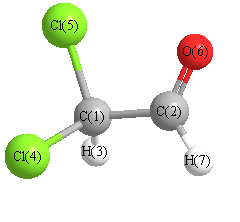Jump to
S1C2
Vibrational Frequencies calculated at CCSD(T)/6-31+G**
Geometric Data calculated at CCSD(T)/6-31+G**
Electronic energy levels
Charges, Dipole, Quadrupole and Polarizability
Jump to
S1C1
Energy calculated at CCSD(T)/6-31+G**
| | hartrees |
|---|
| Energy at 0K | -1071.482292 |
| Energy at 298.15K | |
| HF Energy | -1070.704023 |
| Nuclear repulsion energy | 265.096978 |
The energy at 298.15K was derived from the energy at 0K
and an integrated heat capacity that used the calculated vibrational frequencies.
Vibrational Frequencies calculated at CCSD(T)/6-31+G**
| Mode Number |
Symmetry |
Frequency
(cm-1) |
Scaled Frequency
(cm-1) |
IR Intensities
(km mol-1) |
Raman Act
(Å4/u) |
Dep P |
Dep U |
|---|
| 1 |
A |
3153 |
3026 |
|
|
|
|
| 2 |
A |
3039 |
2916 |
|
|
|
|
| 3 |
A |
1795 |
1722 |
|
|
|
|
| 4 |
A |
1423 |
1365 |
|
|
|
|
| 5 |
A |
1297 |
1245 |
|
|
|
|
| 6 |
A |
1269 |
1217 |
|
|
|
|
| 7 |
A |
1049 |
1006 |
|
|
|
|
| 8 |
A |
954 |
916 |
|
|
|
|
| 9 |
A |
839 |
806 |
|
|
|
|
| 10 |
A |
660 |
634 |
|
|
|
|
| 11 |
A |
612 |
587 |
|
|
|
|
| 12 |
A |
355 |
340 |
|
|
|
|
| 13 |
A |
280 |
269 |
|
|
|
|
| 14 |
A |
224 |
215 |
|
|
|
|
| 15 |
A |
74 |
71 |
|
|
|
|
Unscaled Zero Point Vibrational Energy (zpe) 8511.0 cm
-1
Scaled (by 0.9596) Zero Point Vibrational Energy (zpe) 8167.2 cm
-1
See section
III.C.1 List or set vibrational scaling factors
to change the scale factors used here.
See section
III.C.2
Calculate a vibrational scaling factor for a given set of molecules
to determine the least squares best scaling factor.
Geometric Data calculated at CCSD(T)/6-31+G**
Point Group is C1
Cartesians (Å)
| Atom |
x (Å) |
y (Å) |
z (Å) |
|---|
| C1 |
0.101 |
-0.035 |
0.508 |
| C2 |
-0.735 |
-1.274 |
0.166 |
| H3 |
0.211 |
0.027 |
1.592 |
| Cl4 |
1.742 |
-0.289 |
-0.161 |
| Cl5 |
-0.642 |
1.462 |
-0.058 |
| O6 |
-1.861 |
-1.238 |
-0.290 |
| H7 |
-0.220 |
-2.221 |
0.398 |
Atom - Atom Distances (Å)
| |
C1 |
C2 |
H3 |
Cl4 |
Cl5 |
O6 |
H7 |
| C1 | | 1.5334 | 1.0909 | 1.7900 | 1.7644 | 2.4355 | 2.2125 |
C2 | 1.5334 | | 2.1490 | 2.6856 | 2.7467 | 1.2151 | 1.1025 | H3 | 1.0909 | 2.1490 | | 2.3487 | 2.3465 | 3.0706 | 2.5816 | Cl4 | 1.7900 | 2.6856 | 2.3487 | | 2.9598 | 3.7276 | 2.8100 | Cl5 | 1.7644 | 2.7467 | 2.3465 | 2.9598 | | 2.9710 | 3.7350 | O6 | 2.4355 | 1.2151 | 3.0706 | 3.7276 | 2.9710 | | 2.0324 | H7 | 2.2125 | 1.1025 | 2.5816 | 2.8100 | 3.7350 | 2.0324 | |
 More geometry information
More geometry information
Calculated Bond Angles
| atom1 |
atom2 |
atom3 |
angle |
|
atom1 |
atom2 |
atom3 |
angle |
| C1 |
C2 |
O6 |
124.376 |
|
C1 |
C2 |
H7 |
113.133 |
| C2 |
C1 |
H3 |
108.773 |
|
C2 |
C1 |
Cl4 |
107.569 |
| C2 |
C1 |
Cl5 |
112.606 |
|
H3 |
C1 |
Cl4 |
106.700 |
| H3 |
C1 |
Cl5 |
108.215 |
|
Cl4 |
C1 |
Cl5 |
112.755 |
| O6 |
C2 |
H7 |
122.478 |
|
Electronic energy levels
Charges, Dipole, Quadrupole and Polarizability
